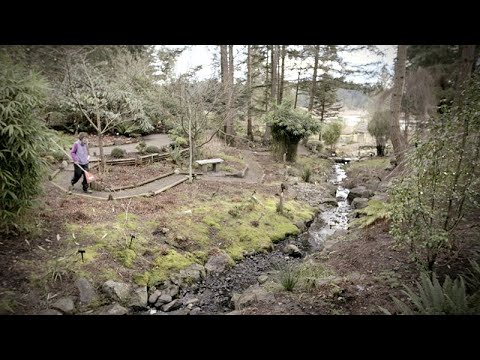Career Overview
Landscape and horticulture technicians and specialists do a range of landscaping and plant-related jobs.
In general, they design, install and maintain landscapes. They assess project sites, advise clients and sketch and build models. They also construct and maintain landscaped environments like gardens, parks and golf courses. They breed and grow plants, as well as diagnose and treat plants affected by pests/disease.
Job Titles
Duties
Arborists and tree service technicians:
- Examine trees and shrubs to diagnose problems/disease
- Prune and spray trees and shrubs, repair damaged areas, as well as inject them with treatment solutions
- Remove unhealthy branches or entire trees when necessary
Golf course superintendents:
- Direct landscaping crews
- Manage landscape renovations and installations
- Apply fertilizers and pesticides
Horticulturists:
- Plan plantings
- Plant seeds
- Water, prune and fertilize plants
- Maintain landscapes
Landscape designers and landscape architectural technicians and technologists:
- Survey and assess sites
- Prepare drawings, sketches and reports
- Assist landscape architects with other design duties
Landscape gardeners / landscapers:
- Plant and maintain private and public lawns and gardens
- Plan and build landscapes that may include trees, shrubs, lawns, fences, decks or patios
Lawn care specialists:
- Assess the health of lawns
- Apply fertilizers, pesticides and other lawn-care products
Earnings
Earnings is income that workers receive in exchange for their labour. Depending on the type of employment, earnings can be in the form of wages (hourly), salaries (fixed monthly or annual) or self-employed earnings.
Work Environment
# Workers Employed
4,705% Employed Full Time
49%Landscape and horticulture technicians and specialists can work for different employers. These include landscape designers, lawn and tree care companies, golf courses, nurseries, greenhouses, public gardens and municipal, provincial and national parks. Many are self-employed.
Most landscape and horticulture technicians and specialists work standard hours, or sunrise to sunset, with longer hours during peak seasons. In some regions of the province, workers may face periods of unemployment during the winter. Greenhouse workers and workers with experience have better prospects for year-round work.
Most tasks take place outside, where workers are exposed to the weather. Landscape designers and greenhouse and nursery workers also work indoors.
Much of the work is physical and dirty. It can involve dangerous equipment, such as chain saws and chippers, as well as toxic chemicals like fertilizers and pesticides. Workers bend, lift heavy objects, kneel for long periods and do repetitive tasks like weeding and digging. Arborists and tree service technicians work at heights, using ladders and boom trucks as well as climb trees. All landscape and horticulture technicians and specialists must take safety measures to avoid injury.
Career Pathways
Workers new to the field usually join an existing company in an entry-level position. With experience, they may become supervisors or start their own businesses. Some landscape and grounds maintenance labourers, for example, may become crew leads or golf course superintendents. Others may become self-employed landscape gardeners or landscapers.
With additional workshops and certifications, workers can advance further or specialize in a particular area.
Related Careers
Occupational Interests
It’s important to understand what kinds of occupations align with your interests.
For more about occupational interests visit Skills for the Future Workforce > Characteristics.
Here are the top occupational interest(s) for this career profile:
Education, Training and Skills
Most workers learn through on-the-job training. Some employers seek workers with a university degree or college diploma in agronomy, arboriculture, horticulture, landscaping, landscape design or landscape technology. Golf course superintendents, landscape gardeners and landscapers may need prior experience as landscape and grounds maintenance labourers.
To apply certain chemical pesticides, workers need a provincial pesticide applicator certificate. Other certifications are not usually required, but may be helpful. The Canadian Nursery Landscape Association’s Landscape Horticulture Certification Program offers national certification for landscape technicians, designers and managers. The Pacific Northwest Chapter of the International Society of Arboriculture (PNW-ISA) offers certifications for arborists and other tree workers.
Apprenticeship programs
SkilledTradesBC offers apprenticeship programs for interested landscape horticulturists and arborist technicians. Those who wish to be certified must complete the apprenticeship program (four years for landscape horticulturists; one year for arborist technicians) or a combination of courses and work experience. Apprenticeship programs include work experience and in-class instruction. Some part-time and online programs are available. To apprentice, workers must be sponsored by an employer. A person who successfully completes an apprenticeship program and the final certification exam earns a Certificate of Qualification. Uncertified workers with significant work experience in the trade may apply to challenge the certification exam to earn the Certificate of Qualification.
To work in other provinces
Workers may need Red Seal certification to work in other provinces. This can be earned through work experience and successful completion of an exam. Uncertified workers with significant experience in the trade can apply to challenge the exam.
Workers coming to B.C.
Those who are certified for an occupation by a regulator elsewhere in Canada can apply for the same certification from the regulator in B.C. Under the terms of the Canadian Free Trade Agreement (CFTA), most applicants who are transferring their credentials from elsewhere in Canada will not be required to complete additional training or testing. However, the B.C. regulator may ask applicants to provide further information, such as a letter of good standing, references or criminal record check.
Workers who trained outside of Canada
For those who trained outside of Canada and never received certification from any Canadian jurisdiction, a full assessment is likely needed. Most occupational regulators have a process for assessment and recognize internationally trained applicants. Contact SkilledTradesBC for details on how to apply for certification in B.C.
For information about labour mobility in Canada, visit www.workersmobility.ca.
View a list of Professional Regulatory Authorities in B.C.
Education programs in B.C.
The following program areas are related to this occupation:
- Agriculture Related
- Horticulture/Floral Related

Skills
Every job calls for a certain set of skills. Knowing those skills is the first step in finding a good career fit.
Here, you will find the 10 most relevant workplace skills. Some are more important to achieving success in a certain career than others. These skills may come naturally to you or you may need to gain them through education, training and experience.
See the list of work-related skills below, ranked in order of importance for this career. Check out the list and see if this career matches your skills—take that first step!
Controlling operations of equipment or systems.
Watching gauges, dials or other indicators to make sure that a machine is working properly.
Using logic and reasoning to identify the strengths and weaknesses of alternative solutions, conclusions or approaches to problems.
Talking to others to share information effectively.
Adjusting actions in relation to others' actions.
Giving full attention to what other people are saying, taking time to understand the points being made, asking questions as appropriate, and not interrupting at inappropriate times.
Keeping track of and assessing your performance, other individuals, or organizations to make improvements or take corrective action.
Actively looking for ways to help people.
Managing one’s own time and the time of others.
Being able to solve novel, ill-defined problems in complex, real-world settings.
Labour Market Statistics
Discover data, facts and information that have been gathered and analyzed. Learn about the characteristics of the economy and labour market in B.C.
Employment
Find out about employment types and trends by region and industry.
Employment
4,705Employment by Region







| Region | Employment | % Employment of this Occupation |
|---|---|---|
| Cariboo | 65 | 1.4% |
| Kootenay | 235 | 5.0% |
| Mainland/Southwest | 2,325 | 49.4% |
| North Coast and Nechako | 45 | 1.0% |
| Northeast | 10 | 0.2% |
| Thompson-Okanagan | 685 | 14.5% |
| Vancouver Island/Coast | 1,335 | 28.3% |
Labour Market Outlook
The B.C. Labour Market Outlook is a 10-year forecast of the expected supply and demand for labour in the province. It’s usually updated every year. The purpose is to provide British Columbians with the knowledge to make informed decisions on careers, skills training, education and hiring.
Forecasted Job Openings (2024-2034)
1,550Forecasted Job Openings
Forecasted Employment Growth Rate
Composition of Job Openings
Job Openings by Region (2024-2034)







| Region | Job Openings | Avg. Annual Employment Growth |
|---|---|---|
| Cariboo | 20 | 0.6% |
| Kootenay | 70 | 1.1% |
| Mainland/Southwest | 710 | 1.1% |
| North Coast and Nechako | 10 | 0.0% |
| Northeast | Not available | Not available |
| Thompson-Okanagan | 230 | 1.1% |
| Vancouver Island/Coast | 500 | 1.2% |
Industry Highlights
Learn about the opportunities in B.C.'s major industries, including employment trends, earning potential, locations of work and more.
Forecasted Job Openings by Industry
| Industry | Job Openings (2024-2034) |
|---|---|
| Business, Building and Other Support Services | 650 |
| Information, Culture and Recreation | 320 |
| Public Administration | 220 |
| Professional, Scientific and Technical Services | 150 |
| Agriculture and Fishing | 50 |
Insights from Industry
In general, landscape and horticulture technicians and specialists are in high demand and enjoy a great deal of job satisfaction.
The need for workers continues to rise with increases in housing construction and renovation, parks and more public interest in gardening and golfing. Landscape design, greenskeeping services, and landscape and garden maintenance have seen the biggest boost.
Resources
-
Agriculture and Agri-Food Canadaagriculture.canada.ca/en
-
Applied Science Technologists and Technicians of BC (ASTTBC)www.asttbc.org
-
British Columbia Golf Superintendents Associationbcgsa.com
-
British Columbia Landscape and Nursery Association (BCLNA)bclna.com
-
British Columbia Recreation and Parks Association (BCRPA)www.bcrpa.bc.ca/
-
Canadian Agricultural Human Resource Council (CAHRC)cahrc-ccrha.ca
-
Canadian Nursery Landscape Association (CNLA)cnla.ca
-
Environmental Careers Organization of Canada (ECO Canada)eco.ca
-
HortEducation.cahorteducation.ca
-
Horticulture Centre of the Pacific (HCP)hcp.ca
-
International Society of Arboriculture, Pacific Northwest chapter (PNW-ISA)pnwisa.org
-
Pacific Horticulture Collegehcp.ca/pacific-horticulture-college
-
Red Seal Programwww.red-seal.ca/eng/welcome.shtml
-
SkilledTradesBCskilledtradesbc.ca/
-
WorkBC Trades Trainingnumber41media1.gathercontent.com/item/12593104









